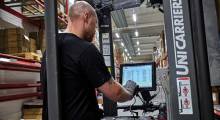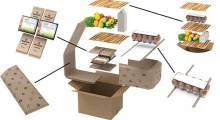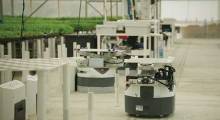The process of storing, retrieving and marrying up lenses and eyeglass frames in VSP Optics Group’s lab in Folsom, Calif., is elegant and deceptively simple. The solution brings together automated storage and robotics while warehouse execution software (WES) is the critical component that makes it all work.
Step 1: The process begins when VSP receives an electronic order from an optometrist. All of the components for that order ride through the processes in a plastic work tray. The system generates a bar code label that is applied to the envelope that is used to store the lenses through various production processes and in the mini-load AS/RS. The bar code label will be read by the various machines used in production. The envelope is put into the work tray along with the two pucks that will be ground into lenses.
Step 2: The work tray is routed to a grinding and polishing workstation and then to tinting (not shown). After that, the lenses are placed into the bar code labeled envelope and the work tray is transported to the one of three induction stations (1) to the three-aisle mini-load automated retrieval and storage system (2). The associates scan the envelope into a plastic tote and induct them into the mini-load as work in process. The system automatically chooses a putaway location.

Step 3: Frames typically arrive the next day. They are measured for size and shape, placed into a bar code labeled envelope and transported to the mini-load system. Associates scan the bar code label and the system searches to see if the matching lenses are in the mini-load (2), ready for finishing. If no lenses are ready, the frames are placed in a plastic tote and inducted into the mini-load, where they are stored until the lenses are ready.
Step 4: If both lenses and frames are present, the frames are conveyed to the robotic piece picking station (3). The station consists of two robots: One picks lenses and the other picks frames. The components for an order are placed on a plastic work tray and conveyed (4) to the finishing department (not shown), where the lenses are cut to their final shape and fitted into the frame.
Step 5: Next, glasses are tinted if required. Finally, they travel to a final inspection process (not shown) where the prescription is verified and they are ready for shipment back to the optometrist.
System suppliers
System integration, conveyor and warehouse execution software: Wynright, wynright.com
Automated storage and retrieval: Daifuku, daifuku.com/us
Robotic automation: Fanuc America, robot.fanucamerica.com







